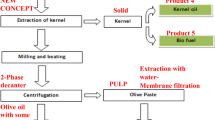Abstract
Olive oil production is a significant economic activity in the Mediterranean basin and a considerable employment source, while the environmental pressures associated with the olive tree farming and olive oil extraction are remarkable and increasingly important. Olive farming and olive oil processing are generating large quantities of solid and liquid wastes, the disposal of which are still considered as a major problem for the farmers and the mill operators. The commonly applied management practice of combustion is not fully in line with sustainability criteria. Taking into consideration that the average size of olive groves and olive mills in the Mediterranean countries is relatively small, the management of olive farming wastes via thermochemical routes could develop an energy self-maintained decentralized system that contributes to the conservation of natural resources and is in line with the principles of ecology and sustainable agriculture. In this context, this work investigates pyrolysis and gasification as potential scenarios for waste management in the case of an olive grove of 10 hectares. The results have shown that the produced electricity, in both cases, is not only enough to cover the energy required for milling operations but is also producing a surplus that can be supplied to the grid and sold, thus providing an extra income to the farmer, boosting the economic viability of all the process. Pyrolysis, in addition, has the advantage of providing a soil amendment (bio-char), thus enhancing soil quality and carbon sequestration into the soil.




Similar content being viewed by others
References
UNEP: Converting Waste Agricultural Biomass into a Resource, Compendium of Technologies. http://www.unep.org/ietc/Portals/136/Publications/Waste%20Management/WasteAgriculturalBiomassEST_Compendium.pdf (2009). Accessed May 2015
International Olive Council. http://www.internationaloliveoil.org/estaticos/view/131-world-olive-oil-figures (2013). Accessed Apr 2014
Azbar, N., Bayhram, A., Filibeli, A., Muezzinoglu, A., Sengul, F., Ozer, A.: A review of waste management options in olive oil production. Crit. Rev. Environ. Sci. Technol. 34(3), 209–247 (2004)
Papadopoulos, A., Mentzis, A., Georgiou, K., Cortés, J.M., Larrazabal, I.L., Avraamides, M., Papadakis, G.: Guidelines for the eco-production of olive oil. European Commission. http://ec.europa.eu/environment/life/project/Projects/index.cfm?fuseaction=home.showFile&rep=file&fil=Ecoil_guidelines2.pdf (2006). Accessed Apr 2014
Tsagaraki, E., Lazarides, H.N., Petrotos, K.B.: Olive Mill Waste Water and Treatment. In: Oreopoulou, V., Russ, W. (eds.) Utilization of By-Products and Treatment of Waste in the Food Industry, pp. 133–158. Springer, New York (2007)
Arvanitoyannis, I., Kassaveti, A., Stefanatos, S.: Current and potential uses of thermally treated olive oil waste. Int. J. Food Sci. Technol. 42(7), 852–867 (2007)
Caputo, A., Scacchia, F., Pelagagge, P.: Disposal of by-products in olive oil industry: waste-to-energy solutions. Appl. Therm. Eng. 23(2), 197–214 (2003)
Zabaniotou, A., Kalogiannis, G., Kappas, E., Karabelas, A.: Olive residues (cuttings and kernels) rapid pyrolysis product yields and kinetics. Biomass Bioenergy 18(5), 411–420 (2000)
Masghounia, M., Hassairi, M.: Energy applications of olive-oil industry by-products: I. The exhaust foot cake. Biomass Bioenergy 18(3), 257–262 (2000)
Beaufoy, G.: The Environmental Impact of Oil Olive Production in the European Union: Practical Options for Improving the the Environmental Impact. http://ew.eea.europa.eu/Agriculture/Agreports/oliveoil.pdf (2002). Accessed Apr 2014
Chan, K.Y., Van Zwieten, L., Meszaros, I., Downie, A., Joseph, S.: Agronomic values of greenwaste biochar as a soil amendment. Aust. J. Soil Res. 45(8), 629–634 (2007)
Alvum-Toll, K., Karlsson, T., Ström, H.: Biochar as soil amendment. A comparison between plant materials for biochar. http://stud.epsilon.slu.se/2572/1/alvum_toll_k_etal_110509.pdf (2011). Accessed Apr 2014
Zheng, W., Sharma, B.K., Rajagopalan, N.: Using Biochar as a Soil Amendment for Sustainable Agriculture. Illinois Department of Agriculture, Illinois (2010)
Hunt, J., DuPonte, M., Sato, D., Kawabata, A.: The Basics of Biochar: A Natural Soil Amendment. http://www.ctahr.hawaii.edu/oc/freepubs/pdf/SCM-30.pdf (2010). Accessed Apr 2014
Eurostat. http://ec.europa.eu/eurostat/statistics-explained/index.php/Agricultural_production_-_orchards (2014). Accessed May 2015
Prodosol, http://www.prosodol.gr/?q=node/203 (2011). Accessed 15 Apr 2014
Guzmán, G., Alonso, A.: A comparison of energy use in conventional and organic olive oil production in Spain. Agric. Syst. 98(3), 167–176 (2008)
Pattara, C., Cappelletti, G., Cichelli, A.: Recovery and use of olive stones: commodity, environmental and economic assessment. Renew. Sustain. Energy Rev. 14(5), 1484–1489 (2010)
Pabir, B.: Biomass Gasification, Pyrolysis, and Torrefaction-Practical Design and Theory, 2nd edn. Elsevier, San Diego (2013)
Putun, A., Uzun, B., Apaydin, E., Putun, E.: Bio-oil from olive oil industry wastes: pyrolysis of olive residue under different conditions. Fuel Process. Technol. 87(1), 25–32 (2005)
Caglara, A., Demirbas, A.: Hydrogen rich gas mixture from olive husk via pyrolysis. Energy Convers. Manag. 43(1), 109–117 (2002)
Jauhiainen, J., Martin-Gullon, I., Conesa, J.A., Font, A.: Emissions from pyrolysis and combustion of olive oil solid waste. J. Anal. Appl. Pyrolysis 74(1–2), 512–517 (2005)
Sensoz, S., Demiral, I., Gercel, H.: Olive bagasse (Olea europea L.) pyrolysis. Bioresour. Technol. 9(3), 429–436 (2006)
Mertzis, D., Mitsakis, P., Tsiakmakis, S., Manara, P., Zabaniotou, A., Samaras, Z.: Performance analysis of a small-scale combined heat and power system using agricultural biomass residues: The SMARt-CHP demonstration project. Energy 64, 367–374 (2014)
Demirbas, A., Caglar, A., Akdeniz, F., Gullu, D.: Conversion of olive husk to liquid fuel by pyrolysis and catalytic liquefaction. Energy Sour. 22(7), 631–639 (2010)
Earle, R.L., Earle, M.D.: The New Zealand Institute of Food Science and Technology. http://www.nzifst.org.nz/unitoperations/drying1.htm (2004). Accessed Apr 2014
Vera, D., Jurado, F., Panopoulos, D., Grammelis, P.: Modelling of biomass gasifier and microturbine for the olive oil industry. Int. J. Energy Res. 74(1–2), 355–367 (2012)
Vakalis, S., Prando, D., Patuzzi, F., Mimmo, T., Gasparclla, A., Tirlcr, W., Dal Savio, S., Chiaramoni Prussi, M., Baraticri, M.: Experiences in biomass gasification in South-Tyrol: the ‘GAST’ project. In: Proceedings for the 21st European Biomass Conference & Exhibition, Copenhagen, 3–7 June 2013
Acknowledgments
Acknowledgements are expressed to European Commission, FA COST Action TD1203 Food waste valorization for sustainable chemicals, materials & fuels (EUBis) and Directorate-General for Research & Innovation, SP4—Capacities, Coordination and Support Action (FP7), Regpot 2011-1, Grant Agreement No. 286269.
Author information
Authors and Affiliations
Corresponding author
Rights and permissions
About this article
Cite this article
Zabaniotou, A., Rovas, D. & Monteleone, M. Management of Olive Grove Pruning and Solid Waste from Olive Oil Extraction Via Thermochemical Processes. Waste Biomass Valor 6, 831–842 (2015). https://doi.org/10.1007/s12649-015-9403-2
Received:
Accepted:
Published:
Issue Date:
DOI: https://doi.org/10.1007/s12649-015-9403-2




